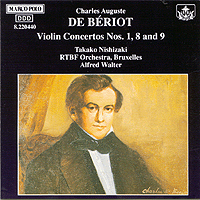These concertos by Bériot are little known and
the catalogue entries show only two chamber pieces and a Scène
de Ballet in addition to this Marco Polo release. This fact should not
put off the disc collector from exploring the fresh and engaging style
of this Belgium virtuoso composer. Two of the concertos are short at
around 13 minutes when compared with the 25-30 minutes of Mozart/Tchaikovsky
standards. If Bériot's other concertos are of similar short duration
one wonders if this is the reason why we do not hear of them in the
concert hall since engaging a soloist for such short programme items
would be uneconomic. We are not told why these particular concertos
were chosen for the recording: certainly they have much appeal and are
well worth a listening. The brilliant violinist, Takako Nishizaki, needs
no introduction to collectors of the Marco Polo label.
Charles-Auguste Bériot was born in Louvain,
Belgium in 1802. He was to become one of the most distinguished violinists
of the Belgian school having played a Viotti concerto in public at the
age of nine. After the early death of his parents in 1812 he became
the ward of his teacher Jean-François Tiby.
Bériot took lessons from André Robberechts,
a pupil of Viotti, and in 1821 played for Viotti in Paris. (In 1819
Viotti had taken up the position of director of the Paris Opera.) He
was advised by the master to try to perfect his style, to listen to
all talented players but to imitate none – counsel that he appears to
have accepted. Bériot took lessons from Baillot, who had for
some years been teaching at the Conservatoire.
By 1824, Bériot had embarked on a career as
a virtuoso that brought him the title of Chamber-violinist to King Charles
X (1826) and thereafter the position of violinist to King William I
of the Netherlands. His meeting with the distinguished soprano Maria
Malibran lead to a partnership with her and finally to marriage. Maria
Malibran, however, died unexpectedly in Manchester in 1836 shortly after
their marriage, yet a few years later Heine was to observe that the
soul of Malibran continued to sing through the melting, sweet tones
of her husband's violin.
Bériot's concert tours with Malibran had up
to now been chiefly in Italy and England. In 1838 he toured Austria
and appeared in the major cities of Germany with the pianist Thalberg.
Then in 1843 he accepted the position of principal professor of the
violin at the Conservatoire in Brussels where he was offered the succession
to Baillot, but failing eye-sight was to lead to Bériot's resignation
from the Conservatoire in 1852. He continued to give concerts, however,
until paralysis of the left arm in 1866 put an end to his career.
Bériot's compositions include 15 sets of variations
for violin and piano, ten violin concertos, some 50 duets and studies
which continue to serve their original pedagogical purpose. As a teacher
and player he lifted the Franco-Belgian school of violin-playing to
its zenith.
The Violin Concerto No. 1 in D Major
was first performed by the composer on Christmas Day, 1829. The work
was dedicated to Leopold I, the first King of the Belgians. In one movement,
the concerto provides an example of Bériot 's early debt to Paganini
in a score that demands technical virtuosity, particularly in the use
of left-hand pizzicato. The work is seductively operatic in melodic
invention, reminding us of the contemporary comparison of Bériot
to Bellini. The notes tell us that it was originally written for a violin
tuned a semitone higher, enabling the soloist to finger in the key of
D while the orchestra played in the key of E flat.
The Concerto No. 8 in D Major was written
in 1855 and published in the following with a dedication to the Prince
Nikolai Yusupov, an amateur Russian violinist and composer. The work
exemplifies yet again Bériot's absorption of contemporary styles
of display and taste in melody and melodic decoration. The concerto
ends with a finale of spirited energy that runs on from the slow movement.
The Violin Concerto No.9 in A was dedicated
to the Princess Tatiana Yusupov. Like the sixth and seventh concertos,
the ninth is in three movement, each played in succession without a
break. It demonstrates the facility of Bériot's writing for the
operatic elegance and fluency of style.
Surprisingly the CD notes omit a biography of Takako
Nishizaki who is a particularly experienced and accomplished violinist:
she provides a bright and energetic performance of the three works.
It should be mentioned that her father was co-founder of the Suzuki
Method and Takako was in fact one of the first students to complete
a Suzuki course. She has a close association with Naxos and has made
other Marco Polo/Naxos recordings.
Alfred Walter was born in Bohemia of Austrian parents,
is a specialist in German music and has conducted regularly in European
countries. He became principal conductor of the RTBF Orchestra in 1984
and occupied the post when this recording was made. Here he directs
with understanding, sensitivity and feeling to maximise sensual impact
from the scores.
The recording is well balanced with the violin forwardly
placed to maximise the gifted playing and good tone of the instrument.
The orchestra's support with warm ambience is delightful. The notes
give more than adequate detail on the composer but less so on the works.
They are provided in English only.
Raymond J Walker


